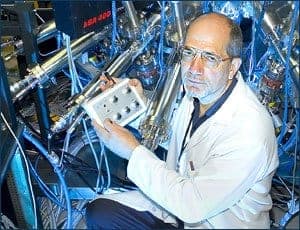
High-temperature superconductivity has been seen for the first time in a layer of material just a few atoms thick. The finding, made by physicists in the US, could allow ultrathin superconductors to be used in transistor-like devices that would require much less power than conventional circuits. The researchers also think the work could shed light on the origin of high-temperature superconductivity.
Most known high-temperature superconductors are “cuprates”, consisting of parallel layers of copper oxide, each just a few nanometres thick. While interactions between electrons within individual layers are believed to make these materials superconduct, a theory of exactly how this happens has proven elusive. Conventional “BCS” theory, which successfully describes conventional, low-temperature superconductors such as lead, simply does not work.
One challenge in creating a theory of high-temperature superconductors is knowing how to deal with interactions between electrons in neighbouring layers, which tend to complicate the calculations. Some researchers have therefore sought to make single-layer superconductors to find out what is going on experimentally. Unfortunately, it has not been easy to make a flat ultrathin film and prevent it from being contaminated by exposure to air.
Metal and insulator sandwich
Now, however, Ivan Bozovic and colleagues at Brookhaven National Laboratory along with researchers at Cornell University and the FEI Company in Oregon have got around these problems by creating an ultrathin layer of lanthanum-strontium copper oxide (LSCO) superconductor, sandwiched between two much thicker non-superconducting layers. As well as protecting the LSCO from the air, the two thicker layers ensure that the superconductor is extremely flat (Nature 455 782).
When LSCO contains very little (or no) strontium it is an insulator. But as more strontium is added, it becomes first a superconductor and then a metal at higher concentrations. Using molecular beam epitaxy, the team made a series of samples in which a thick layer of metallic LSCO was deposited onto a thick layer of insulating LSCO or vice versa. The interface between the metal and insulator layers was found to contain a superconducting layer about 2–3 nm thick — which corresponds to 1–2 unit cells of the LSCO lattice.
This ultrathin layer becomes superconducting below a critical temperature (Tc) of 50 K, which is 10 K warmer than the Tc seen in much thicker samples of superconducting LSCO. According to Bozovic, the greatest challenge facing the team was proving that the superconductivity was occurring only in the “quasi-2D” ultrathin layer, rather than in a much thicker 3D region of sample. They did this using several different techniques, including atomic-resolution transmission-electron microscopy, to show that there was an abrupt change in strontium concentration right at the interface, which confirmed that the thick LSCO layers were insulators and metals, not superconductors.
High-Tc metamaterial
Bozovic told physicsworld.com that the team is now looking at how ultrathin layers could be stacked on one another to create a superconductor “metamaterial”. He believes that the Tc of such metamaterials could be boosted well above 50 K by adjusting the separation between layers — and hence the interactions between electrons.
Ultrathin superconductors are also interesting from a technological point of view because, unlike their 3D counterparts, they should not completely screen electric fields. This means that they could, in principle, be used to make the superconducting equivalent of a field-effect transistor — something that Bozovic and colleagues are now trying to make. Thanks to the lack of electrical resistance, such devices could run faster than their semiconductor counterparts while consuming much less power.



